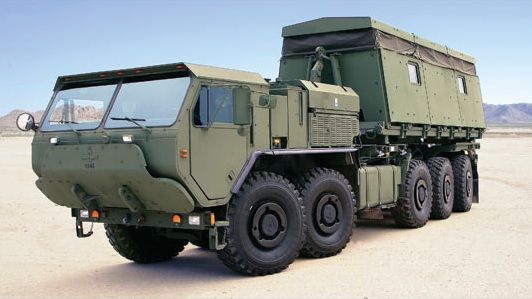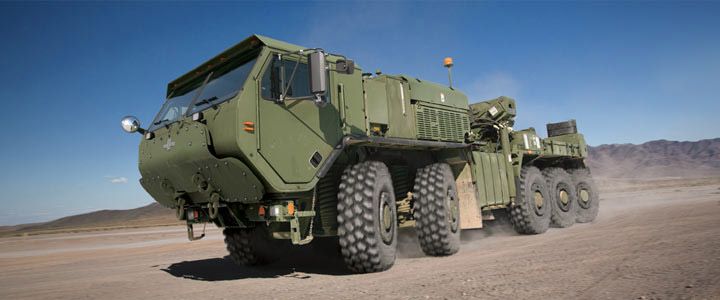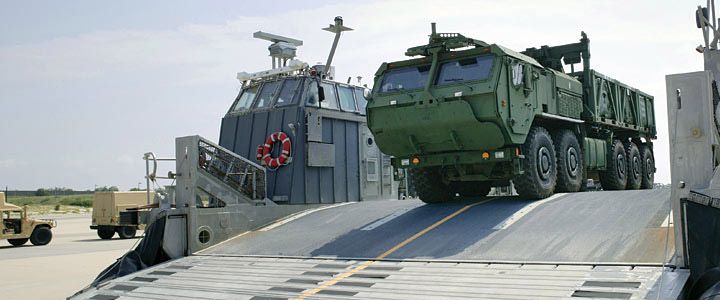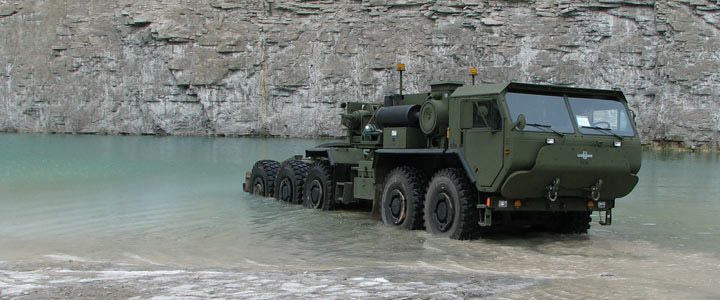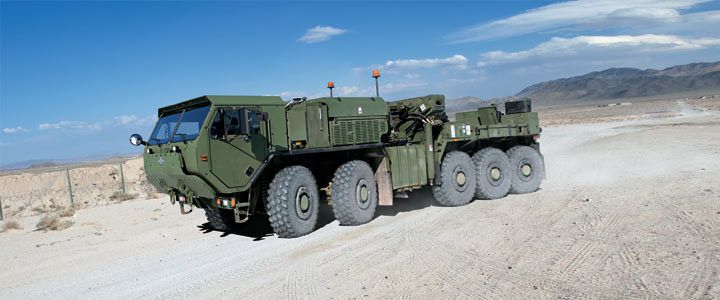Let’s face it; the U.S. Military gets involved anywhere it is needed, and the unfortunate reality is that a lot of the time those enlisted are putting their lives on the line. The soldiers on deployment often deal with some of the harshest environments and circumstances imaginable, as does the equipment they use. One such piece of equipment is the Oshkosh Defense Logistics Vehicle System Replacement (LVSR,) that has somewhat recently replaced the original Logistics Vehicle System.
The LVSR has been in service in the Middle East since late 2009 when Oshkosh sent the first example to Afghanistan to assist the U.S. Marine Corps in early October. It is designed to haul cargo, trailers, and even act as a wrecker when properly equipped. What’s more, Oshkosh sends out Field Service Representatives, who work side-by-side with our troops to offer training and support for these vehicles when needed. With a payload capacity of 22.5 tons (45,000 pounds) on-road and 16.5 tons off-road, the LVSR is a pretty mean machine.
When the first LVSR was deployed to Afghanistan, Andy Hove – President and Executive Vice President of Oshkosh Defense – said, “The fielding of this vehicle in Afghanistan is a significant milestone for both the U.S. Marine Corps and Oshkosh Defense. The LVSR expands on the capabilities of the LVS, which has been an integral part of the Marine Corps fleet for nearly 25 years, to negotiate and overcome the most challenging environments, including those found in Afghanistan.”
So what exactly is an LVSR and how does it help the troops? Well, we’ll talk about that a little bit in our review below. So grab yourself a beverage and let’s learn a little about it.
Continue reading to learn more about the Oshkosh Logistics Vehicle System Replacement.
2016 Oshkosh Logistics Vehicle System Replacement
- Make: Array
- Model: 2016 Oshkosh Logistics Vehicle System Replacement
- Horsepower: 310
- Torque: 443
- [do not use] Vehicle Model: Array
Exterior
Alright, let’s not beat around the bush – the LVSR isn’t exactly the prettiest vehicle rolling around the desert in the middle east. But, this monster is designed to do a job, well several, so it’s beauty really comes in the form of the support it offers to our troops on the other side of the world. The LVSR is offered as a wrecker, a tractor trailer, and a cargo hauler, but more importantly, it is also equipped with armor straight from the factory. So, regardless of what model our soldiers are in, they are offered the best protection possible out in the field.
The LVSR is extremely versatile, with all adapters and lifting hardware stored on the vehicle. As you can see from the images, the body of the LVSR is built from cold hard steel. All models carry the same general design with rear-wheel steering and that huge armor plate up front. The headlights and signal lights are mounted under that massive plate. When setup as a wrecker, the vehicle features a front-mounted self-recovery winch with a 20,000-pound straight pull rating. Out back, there are two winches that have a combined, straight-pull rate of 78,000 pounds.
When setup as a tractor, the rear tail of the LVSR looks rather bare with just three wheels on each side and a fifth-wheel hitch on top. It is equipped with a 60,000-pound winch to winch equipment onto the trailer. It has the ability to haul semi-trailers, heavy engineer equipment, and even combat vehicles. As with all LVSR models, the front of the tractor has integrated armor to protect the troops inside.
Moving over to the LVSR Cargo, and the rear end changes significantly. The basic setup is a flatbed, but that flatbed can be equipped with sides and a top for hauling troops, ammunition, flatracks, ISO containers up to 20 feet in length, tactical bridging, support equipment, and fuel containers, among other things. The Cargo is can also be equipped with a hydraulic system that helps to tilt the flatbed – like the rear of a dump truck, for instance – or to help load cargo onto the rear, making life a lot easier for those tasked with the job at hand. As with all models, it can haul up to 22.5 tons of cargo on-road or 16.5 ton off-road. Like I said, versatile.
Interior
As with a lot of military and defense vehicles, the interior of the LVSR is a pretty big mystery. Don’t expect too many luxuries or comforts, as this baby is all about business. The dash is likely littered with gauges and controls that are used to operate the hydraulics and other various equipment. It is also likely that there is some kind of climate control system, but that is just an educated guess considering we have been granted the luxury of looking inside one.
We do know that all models of the LVSR come equipped with the Command Zone integrated control and diagnostics system. This system comes equipped directly from the factory and provides monitoring and monitoring of critical components from within the cab to provide the best safety possible for our deployed troops.
Drivetrain
Despite the fact that the LVSR has been in continuous service since 2009, we know very little about its drivetrain configuration. We do know that it is a 10-by-10 all-wheel-drive vehicle that is powered by a special CAT C15 diesel engine that delivers 600 horsepower. With a Maximum gross vehicle weight rating (GVRW,) the LVSR can push through five feet of water and travel at up to 65 mph on smoothish pavement. It has an on-road cruising range of 300 miles between pit stops.
Needless to say, the LVSR is the ultimate support vehicle for our troops, and it has the ability to go just about anywhere and haul just about anything they might need. With a 600-horsepower diesel engine, and the ability to haul 22.5 tons of anything you can fit on it or attach to it, it’s safe to say it’s probably got plenty of torque as well. I wouldn’t expect it to get up to speed all that fast, but at least the troops inside are protected by the built-in body armor.
Weapons Systems
Since the LVSR isn’t designed specifically for combat functions, there aren’t any weapons systems installed from the factory. That said, the military has some rather capable engineers that have surely devised a way to afford the troops some on-board weapons if needed. Needless to say, the military keeps a pretty tight lid on any weapon systems the vehicle may have.
But we do know that back in September of 2012, the military placed an order that included 186 weapons mount kits (among other things) which tells us for sure that there are at least some weapons in use on the LVSR – we just don’t know specifically what they are. I would expect that the weapon mounts would at least support heavy machine guns of the .50 caliber type. Surely the LVSR could be modified to support some minor ground-to-air missiles or the like as well.
Conclusion
It’s fun to take a look at some of the equipment our troops are relying on to get around, complete missions and keep themselves safe. With it being Memorial Day, I think it’s only right to take a moment to thank the troops currently deploy on active duty, and those who gave the ultimate sacrifice.
With that said, remember that Memorial Day isn’t about a three-day weekend or barbecuing and getting tipsy – it’s about remembering those who left home and sacrificed themselves for the freedom that you and I enjoy every day. So, now that we’ve talked about the LVSR and how it helps our troops, click play on the video above to take a look at it in action. Just imagine how hard these troops would have had to work without the LVSR there to help them.

